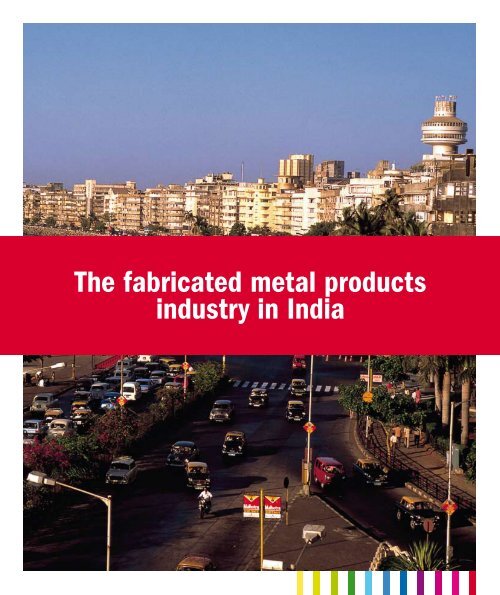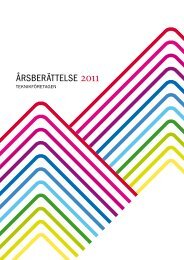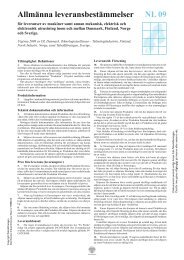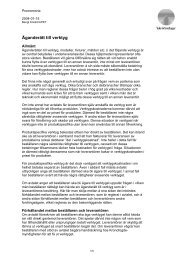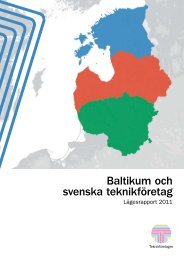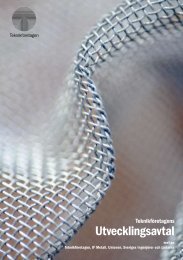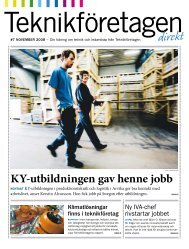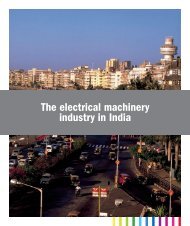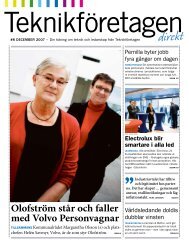in India The fabricated metal products industry in ... - Teknikföretagen
in India The fabricated metal products industry in ... - Teknikföretagen
in India The fabricated metal products industry in ... - Teknikföretagen
You also want an ePaper? Increase the reach of your titles
YUMPU automatically turns print PDFs into web optimized ePapers that Google loves.
<strong>The</strong> <strong>fabricated</strong> <strong>metal</strong> <strong>products</strong><br />
<strong>in</strong>dustry <strong>in</strong> <strong>India</strong>
Foreword<br />
<strong>India</strong> has been one of the world’s fastest grow<strong>in</strong>g economies dur<strong>in</strong>g the last few years.<br />
However, <strong>India</strong> has still not recovered from the effects of the former <strong>in</strong>wardoriented<br />
policies it followed until the 1990s. Economic reforms started tak<strong>in</strong>g place <strong>in</strong><br />
the beg<strong>in</strong>n<strong>in</strong>g of the 1990s when <strong>India</strong> started open<strong>in</strong>g up gradually. <strong>The</strong> question<br />
is whether <strong>India</strong> can implement the required policy changes effectively and develop<br />
a conducive bus<strong>in</strong>ess climate for <strong>in</strong>dustry to grow, and thus be able to susta<strong>in</strong> the<br />
strong rate of growth it has achieved over the past few years.<br />
Dur<strong>in</strong>g this time there has been <strong>in</strong>creas<strong>in</strong>g confidence <strong>in</strong> the manufactur<strong>in</strong>g sector <strong>in</strong><br />
<strong>India</strong> and its long term potential as a manufactur<strong>in</strong>g hub. Importance of the eng<strong>in</strong>eer<strong>in</strong>g<br />
<strong>in</strong>dustry is supreme <strong>in</strong> this regard and it also plays a crucial role <strong>in</strong> the economic<br />
growth of the country. To understand the driv<strong>in</strong>g forces of <strong>India</strong> better, it is essential<br />
to develop an understand<strong>in</strong>g of prevail<strong>in</strong>g fundamentals <strong>in</strong> the eng<strong>in</strong>eer<strong>in</strong>g <strong>in</strong>dustry.<br />
In this report we provide an overview of the eng<strong>in</strong>eer<strong>in</strong>g <strong>in</strong>dustry <strong>in</strong> <strong>India</strong> with<br />
relevant facts regard<strong>in</strong>g the structure and size, growth rates, ma<strong>in</strong> challenges, trends<br />
<strong>in</strong> <strong>in</strong>ternational trade, research and development <strong>in</strong>itiatives, as well as an <strong>in</strong>dication<br />
of future outlook of the ma<strong>in</strong> segments <strong>in</strong> the eng<strong>in</strong>eer<strong>in</strong>g <strong>in</strong>dustry. It is a series of<br />
seven different reports that <strong>in</strong>cludes an overview of the eng<strong>in</strong>eer<strong>in</strong>g <strong>in</strong>dustry, the<br />
automotive <strong>in</strong>dustry, the mach<strong>in</strong>ery and equipment <strong>in</strong>dustry, the electrical mach<strong>in</strong>ery<br />
<strong>in</strong>dustry, the automotive components <strong>in</strong>dustry, the electronic equipment <strong>in</strong>dustry<br />
and the <strong>fabricated</strong> <strong>metal</strong> <strong>products</strong> <strong>in</strong>dustry.<br />
This series of seven different reports has been commissioned by Teknikföretagen,<br />
the Association of Swedish Eng<strong>in</strong>eer<strong>in</strong>g Industries, to provide a detailed overview<br />
of the <strong>India</strong>n eng<strong>in</strong>eer<strong>in</strong>g <strong>in</strong>dustry cover<strong>in</strong>g various aspects of the ma<strong>in</strong> segments.<br />
It is hoped that the reports will help identify areas of bus<strong>in</strong>ess <strong>in</strong>terest for Swedish<br />
eng<strong>in</strong>eer<strong>in</strong>g companies and give the reader <strong>in</strong>creased knowledge of the present<br />
<strong>in</strong>dustrial development <strong>in</strong> <strong>India</strong>.<br />
<strong>The</strong> reports have been authored by Mr. Rahul Sanyal. He is an economist from New<br />
Delhi <strong>in</strong> <strong>India</strong>, and has been appo<strong>in</strong>ted by Teknikföretagen to prepare these seven reports.<br />
Stockholm, September 2008<br />
Anders Rune<br />
Chief Economist
Table of contents<br />
Overview of the <strong>fabricated</strong> <strong>metal</strong> <strong>products</strong> <strong>in</strong>dustry <strong>in</strong> <strong>India</strong>............................................ 5<br />
A snapshot of the <strong>fabricated</strong> <strong>metal</strong> <strong>products</strong> <strong>in</strong>dustry......................................................... 6<br />
Evolution of the <strong>India</strong>n <strong>fabricated</strong> <strong>metal</strong> <strong>products</strong> <strong>in</strong>dustry................................................ 6<br />
Growth of the <strong>fabricated</strong> <strong>metal</strong> <strong>products</strong> <strong>in</strong>dustry............................................................... 7<br />
Growth <strong>in</strong> the manufacture sector is lead<strong>in</strong>g to development of the <strong>in</strong>dustry................. 10<br />
Size and structure of the <strong>fabricated</strong> <strong>metal</strong> <strong>products</strong> <strong>in</strong>dustry......................................... 10<br />
Forg<strong>in</strong>g <strong>in</strong>dustry................................................................................................................... 10<br />
Stamp<strong>in</strong>gs and press<strong>in</strong>gs....................................................................................................... 13<br />
Railway conta<strong>in</strong>ers................................................................................................................ 14<br />
Ship conta<strong>in</strong>ers...................................................................................................................... 16<br />
Metal conta<strong>in</strong>ers.................................................................................................................... 17<br />
Safes and vaults..................................................................................................................... 17<br />
Railway coaches and wagons................................................................................................ 18<br />
Ship-build<strong>in</strong>g........................................................................................................................ 19<br />
Research and development................................................................................................... 20<br />
Future outlook.......................................................................................................................... 21<br />
References................................................................................................................................ 23
<strong>The</strong> <strong>fabricated</strong> <strong>metal</strong> <strong>products</strong> <strong>in</strong>dustry is one of the<br />
smaller <strong>in</strong>dustries <strong>in</strong> the manufactur<strong>in</strong>g sector of <strong>India</strong>.<br />
However, with growth <strong>in</strong> many other <strong>in</strong>dustries, there<br />
is an <strong>in</strong>crease <strong>in</strong> derived demand for <strong>fabricated</strong> <strong>metal</strong><br />
<strong>products</strong>. <strong>The</strong> highly fragmented and largely unorganized<br />
<strong>in</strong>dustry is now a focus area <strong>in</strong> the <strong>India</strong>n eng<strong>in</strong>eer<strong>in</strong>g<br />
<strong>in</strong>dustry and measures are be<strong>in</strong>g taken by the<br />
Government of <strong>India</strong> and the <strong>in</strong>dustry to develop the<br />
<strong>fabricated</strong> <strong>metal</strong> <strong>products</strong> <strong>in</strong>dustry further.<br />
4
<strong>The</strong> <strong>fabricated</strong> <strong>metal</strong><br />
<strong>products</strong> <strong>in</strong>dustry <strong>in</strong> <strong>India</strong><br />
Overview of the <strong>fabricated</strong><br />
<strong>metal</strong> <strong>products</strong> <strong>in</strong>dustry <strong>in</strong> <strong>India</strong><br />
<strong>The</strong> <strong>fabricated</strong> <strong>metal</strong> <strong>products</strong> <strong>in</strong>dustry is more unique compared to other <strong>in</strong>dustries<br />
due to the way <strong>in</strong> which it is organized. Compared to the larger and more<br />
mature <strong>in</strong>dustries such as the mach<strong>in</strong>ery and equipment <strong>in</strong>dustry and the automotive<br />
<strong>in</strong>dustry, the <strong>fabricated</strong> <strong>metal</strong> <strong>products</strong> <strong>in</strong>dustry is not as well organized. <strong>The</strong>re<br />
are some ambiguities about the entire range of <strong>products</strong> be<strong>in</strong>g manufactured <strong>in</strong> the<br />
<strong>in</strong>dustry. Thus, from a statistical po<strong>in</strong>t of view, <strong>in</strong>formation regard<strong>in</strong>g production,<br />
number of people employed and <strong>in</strong>ternational trade <strong>in</strong> the <strong>in</strong>dustry is very limited.<br />
However, for this chapter, <strong>in</strong>formation has been obta<strong>in</strong>ed from premier <strong>in</strong>dustry associations<br />
like Federation of <strong>India</strong>n Chambers of Commerce and Industry (FICCI)<br />
and <strong>in</strong>terviews of <strong>in</strong>dustry experts. 1<br />
This <strong>in</strong>dustry is one of the more fragmented <strong>in</strong>dustries <strong>in</strong> the manufactur<strong>in</strong>g<br />
sector <strong>in</strong> <strong>India</strong>. <strong>The</strong>re are a large number of small and unorganized manufacturers<br />
<strong>in</strong> the small scale <strong>in</strong>dustry and few large companies <strong>in</strong> each segment. Some of the<br />
segments <strong>in</strong> the <strong>in</strong>dustry like railway and ship conta<strong>in</strong>ers, forg<strong>in</strong>g, stamp<strong>in</strong>g and<br />
press<strong>in</strong>g, and conta<strong>in</strong>ers of <strong>metal</strong>s are dom<strong>in</strong>ated by large Public Sector Enterprises<br />
(PSEs) whereas segments like safes and vaults, gas cyl<strong>in</strong>ders, other <strong>fabricated</strong> <strong>metal</strong><br />
<strong>products</strong> are dom<strong>in</strong>ated by Small and Medium Enterprises (SMEs).<br />
<strong>The</strong> <strong>in</strong>dustry’s development has been hampered by general issues like erratic power<br />
supply, gridlocked seaports, poor <strong>in</strong>frastructure, restrictive government policies etc.<br />
Yet the <strong>in</strong>dustry is develop<strong>in</strong>g slowly and grow<strong>in</strong>g as domestic demand is <strong>in</strong>creas<strong>in</strong>g<br />
1) <strong>The</strong> M<strong>in</strong>istry of Statistics and Programme Implementation is responsible for compil<strong>in</strong>g data on the <strong>in</strong>dustry. But the<br />
method of compil<strong>in</strong>g data is not clear and that is why it is uncerta<strong>in</strong> whether the figures are accurate. <strong>The</strong>re is less<br />
<strong>in</strong>formation available on the <strong>in</strong>dustry and that is why <strong>in</strong>formation from <strong>in</strong>dustry associations, <strong>in</strong>terviews of <strong>in</strong>dustry<br />
leaders, journals and news articles have been referred <strong>in</strong> this report.<br />
5
and as an <strong>in</strong>creas<strong>in</strong>g number of global companies are off-shor<strong>in</strong>g their manufactur<strong>in</strong>g<br />
capacities to <strong>India</strong>.<br />
A snapshot of the <strong>fabricated</strong> <strong>metal</strong> <strong>products</strong> <strong>in</strong>dustry<br />
<strong>The</strong> <strong>fabricated</strong> <strong>metal</strong> <strong>products</strong> <strong>in</strong>dustry is small <strong>in</strong> comparison to most segments<br />
of the eng<strong>in</strong>eer<strong>in</strong>g <strong>in</strong>dustry <strong>in</strong> <strong>India</strong>. However the <strong>in</strong>dustry is comparable to other<br />
<strong>in</strong>dustries <strong>in</strong> terms of the number of factories and the number of workers employed.<br />
This is because the <strong>in</strong>dustry is highly fragmented where there are a very large number<br />
of companies produc<strong>in</strong>g a wide range of <strong>metal</strong> components and parts. Due to<br />
the basic nature of be<strong>in</strong>g labour <strong>in</strong>tensive, the <strong>in</strong>dustry employs a very large number<br />
of people. Accord<strong>in</strong>g to the M<strong>in</strong>istry of Commerce and Industry, the <strong>in</strong>dustry<br />
employed 3.69 per cent of the workers and 3.78 per cent of the employees <strong>in</strong> the<br />
manufactur<strong>in</strong>g sector <strong>in</strong> <strong>India</strong> <strong>in</strong> the year 2004–2005. 2<br />
S<strong>in</strong>ce the <strong>in</strong>dustry has been grow<strong>in</strong>g at a slow pace, <strong>in</strong>dustry associations and<br />
research <strong>in</strong>stitutes have formulated plans to help develop the <strong>in</strong>dustry faster. It is<br />
believed that a balanced growth approach for accelerat<strong>in</strong>g growth of large scale manufactur<strong>in</strong>g<br />
clusters across states is essential to give a boost to the <strong>fabricated</strong> <strong>metal</strong><br />
<strong>products</strong> <strong>in</strong>dustry.<br />
Evolution of the <strong>India</strong>n <strong>fabricated</strong> <strong>metal</strong> <strong>products</strong> <strong>in</strong>dustry<br />
Surge <strong>in</strong> the automotive <strong>in</strong>dustry, mach<strong>in</strong>ery and equipment <strong>in</strong>dustry, electronic<br />
equipment <strong>in</strong>dustry and electrical mach<strong>in</strong>ery <strong>in</strong>dustry has <strong>in</strong>creased domestic<br />
demand for <strong>fabricated</strong> <strong>metal</strong> <strong>products</strong> tremendously. <strong>The</strong> <strong>fabricated</strong> <strong>metal</strong> <strong>products</strong><br />
<strong>in</strong>dustry like many other <strong>in</strong>dustries <strong>in</strong> <strong>India</strong> has been develop<strong>in</strong>g to a large extent,<br />
due to the shift of manufactur<strong>in</strong>g facilities from western countries to <strong>India</strong>. Increas<strong>in</strong>g<br />
globalization comb<strong>in</strong>ed with more open trade regimes has helped the <strong>in</strong>dustry<br />
tremendously. As a result, over the past few years, the <strong>in</strong>dustry has witnessed an<br />
<strong>in</strong>crease <strong>in</strong> exports across segments, although over a small base.<br />
After the Asian crisis <strong>in</strong> the late 1990s, <strong>India</strong>’s exports of <strong>fabricated</strong> <strong>metal</strong> <strong>products</strong><br />
<strong>in</strong>creased substantially accompanied by an <strong>in</strong>crease <strong>in</strong> share of world production. At<br />
the same time, the <strong>in</strong>dustry also witnessed a steady <strong>in</strong>crease <strong>in</strong> employment <strong>in</strong> the<br />
<strong>in</strong>dustry. However, even though employment was <strong>in</strong>creas<strong>in</strong>g, an <strong>in</strong>creas<strong>in</strong>g number<br />
of <strong>in</strong>novations were also be<strong>in</strong>g made to make technological changes to <strong>in</strong>crease<br />
2) Reference has been made to M<strong>in</strong>istry of Commerce and Industry (2008a)<br />
6
productivity <strong>in</strong> the <strong>in</strong>dustry. Competitive pressures from other Asian tigers, Korea,<br />
Taiwan, Ch<strong>in</strong>a and Malaysia also led to an <strong>in</strong>crease <strong>in</strong> productivity and exports. 3<br />
Growth of the <strong>fabricated</strong> <strong>metal</strong> <strong>products</strong> <strong>in</strong>dustry<br />
<strong>The</strong> <strong>fabricated</strong> <strong>metal</strong> <strong>products</strong> <strong>in</strong>dustry is a skill <strong>in</strong>tensive <strong>in</strong>dustry requir<strong>in</strong>g<br />
technical expertise – an area <strong>in</strong> which <strong>India</strong> is likely to become a primary sourc<strong>in</strong>g<br />
and manufactur<strong>in</strong>g base for companies worldwide. <strong>The</strong> <strong>in</strong>dustry, has not been a<br />
major contributor to the manufactur<strong>in</strong>g sector and hence to the GDP of <strong>India</strong>,<br />
when compared to other <strong>in</strong>dustries with<strong>in</strong> the manufactur<strong>in</strong>g sector. 4 <strong>The</strong> growth<br />
of the <strong>in</strong>dustry too has been flat, except for a short spurt <strong>in</strong> <strong>in</strong>dustrial production <strong>in</strong><br />
the year 2006–2007, when the <strong>in</strong>dustry grew by 11.4 per cent. Production between<br />
the years 2002–2003 and 2006–2007 has grown at an annual average rate of 5.22<br />
per cent. As can be seen from the figure, the growth trend <strong>in</strong> the <strong>in</strong>dustry has not<br />
been uniform. Recently, accord<strong>in</strong>g to the M<strong>in</strong>istry of Commerce and Industry, the<br />
<strong>in</strong>dustry growth rate has been decl<strong>in</strong><strong>in</strong>g. In the year 2007–2008, between April and<br />
December production decl<strong>in</strong>ed by 7 per cent.<br />
GROWTH TREND OF THE FABRICATED METAL PRODUCTS INDUSTRY<br />
<strong>The</strong> table below depicts the growth rates <strong>in</strong> the <strong>fabricated</strong> <strong>metal</strong> <strong>products</strong> <strong>in</strong>dustry between the years<br />
2002–2003 and 2007–2008.<br />
11.4<br />
6.4<br />
3.7<br />
5.7<br />
-1.1<br />
-7.0<br />
2002–2003 2003–2004 2004–2005 2005–2006 2006–2007 2007–2008<br />
(April to December)<br />
Source: M<strong>in</strong>istry of Commerce and Industry<br />
3) Reference has been made to <strong>The</strong> H<strong>in</strong>du Bus<strong>in</strong>ess L<strong>in</strong>e (1st May 2008)<br />
4) Reference has been made to a report prepared by McK<strong>in</strong>sey & Company. See Luthra et al.<br />
7
Several measures are be<strong>in</strong>g undertaken under the recommendations of the newly<br />
formed National Manufactur<strong>in</strong>g Competitiveness Council (NMCC), Federation of<br />
<strong>India</strong>n Chambers of Commerce and Industry (FICCI) and Confederation of <strong>India</strong>n<br />
Industries (CII) among others. Chief among some of the measures be<strong>in</strong>g suggested<br />
are changes <strong>in</strong> the tax structure, consolidation of SMEs, facilitation of foreign participation<br />
and provision of easier access to required resources.<br />
Some of the factors that affect growth <strong>in</strong> the <strong>fabricated</strong> <strong>metal</strong> <strong>products</strong> <strong>in</strong>dustry are<br />
given below.<br />
Growth closely l<strong>in</strong>ked to <strong>in</strong>ternational trade scenario<br />
<strong>The</strong> growth of the <strong>in</strong>dustry is very closely l<strong>in</strong>ked to the <strong>in</strong>ternational trade scenario.<br />
For <strong>in</strong>stance, an <strong>in</strong>crease <strong>in</strong> exports would lead to an <strong>in</strong>crease <strong>in</strong> conta<strong>in</strong>er traffic,<br />
which would then lead to an <strong>in</strong>creased demand and thus <strong>in</strong>creased production of<br />
<strong>metal</strong> conta<strong>in</strong>ers, ship and railway conta<strong>in</strong>ers etc. Currently, due to the slowdown<br />
<strong>in</strong> the American and European markets, slack <strong>in</strong> the construction and real estate<br />
markets <strong>in</strong> western countries and a surge <strong>in</strong> ocean freight rates, it is believed that<br />
exports would decl<strong>in</strong>e and thus, with respect to the <strong>fabricated</strong> <strong>metal</strong> <strong>products</strong> <strong>in</strong>dustry,<br />
conta<strong>in</strong>er production would rema<strong>in</strong> flat. 5<br />
Low labour productivity<br />
An analysis was conducted by FICCI on the laggard <strong>in</strong>dustry segments of the manufactur<strong>in</strong>g<br />
sector <strong>in</strong> <strong>India</strong>. Fabricated <strong>metal</strong> <strong>products</strong> <strong>in</strong>dustry was one of those<br />
segments. <strong>The</strong> ma<strong>in</strong> focus of the study was to make recommendations to enable<br />
<strong>in</strong>crease <strong>in</strong> productivity. <strong>The</strong>re is <strong>in</strong>creas<strong>in</strong>g competition to <strong>India</strong> from Asian players<br />
such as Ch<strong>in</strong>a, Malaysia and Korea <strong>in</strong> this regard. <strong>The</strong> study revealed that the <strong>fabricated</strong><br />
<strong>metal</strong> <strong>products</strong> <strong>in</strong>dustry <strong>in</strong> <strong>India</strong> was suffer<strong>in</strong>g from low labour productivity.<br />
FICCI suggested, that enhancement of productivity can be achieved by adopt<strong>in</strong>g the<br />
cluster approach. It is believed that if productivity can be <strong>in</strong>creased <strong>in</strong> the <strong>in</strong>dustry,<br />
the fortunes of the <strong>fabricated</strong> <strong>metal</strong> <strong>products</strong> <strong>in</strong>dustry would be much higher than<br />
are projected now. 6<br />
5) Reference has been made to <strong>The</strong> H<strong>in</strong>du Bus<strong>in</strong>ess L<strong>in</strong>e (16th June 2008)<br />
6) Reference has been made to <strong>The</strong> H<strong>in</strong>du Bus<strong>in</strong>ess L<strong>in</strong>e (7th March 2005)<br />
8
Distribution of the largest <strong>fabricated</strong> <strong>metal</strong> <strong>products</strong> producers <strong>in</strong> <strong>India</strong><br />
In the year 2005–2006, accord<strong>in</strong>g to FICCI, the largest states that were produc<strong>in</strong>g<br />
<strong>fabricated</strong> <strong>metal</strong> <strong>products</strong> <strong>in</strong> <strong>India</strong> were Uttar Pradesh (12 per cent), Punjab (5 per<br />
cent), West Bengal (5 per cent) and Karnataka (5 per cent) of production. 7<br />
LARGEST STATES BY PRODUCTION OF FABRICATED METAL PRODUCTS IN INDIA<br />
Rough ocations of these states have been shown <strong>in</strong> the figure below.<br />
Punjab<br />
Uttar Pradesh<br />
West Bengal<br />
Karnataka<br />
Source: Federation of <strong>India</strong>n Chambers of Commerce and Industry<br />
7) Reference has been made to <strong>The</strong> H<strong>in</strong>du Bus<strong>in</strong>ess L<strong>in</strong>e (7th March 2005)<br />
9
Growth <strong>in</strong> the manufacture sector<br />
is lead<strong>in</strong>g to development of the <strong>in</strong>dustry<br />
With the domestic manufactur<strong>in</strong>g sector grow<strong>in</strong>g steadily, the market for the <strong>fabricated</strong><br />
<strong>metal</strong> <strong>products</strong> <strong>in</strong>dustry is set to <strong>in</strong>crease, because the user <strong>in</strong>dustries are<br />
grow<strong>in</strong>g steadily. Currently, the <strong>in</strong>dustry is highly fragmented and scattered. <strong>The</strong><br />
<strong>in</strong>dustry is undergo<strong>in</strong>g much needed structural changes and evaluat<strong>in</strong>g solutions<br />
to challenges such as low productivity. Measures are be<strong>in</strong>g undertaken to develop<br />
the <strong>in</strong>dustry close to manufactur<strong>in</strong>g hubs. For <strong>in</strong>stance, Chennai <strong>in</strong> South <strong>India</strong> is a<br />
major automotive hub. S<strong>in</strong>ce the forg<strong>in</strong>g <strong>in</strong>dustry derives 65–70 per cent of its demand<br />
from the automotive <strong>in</strong>dustry, more forg<strong>in</strong>g companies are be<strong>in</strong>g set up near<br />
Chennai; for <strong>in</strong>stance, Caparo Plc from the United K<strong>in</strong>gdom. 8<br />
Size and structure of the <strong>fabricated</strong><br />
<strong>metal</strong> <strong>products</strong> <strong>in</strong>dustry<br />
<strong>The</strong> <strong>fabricated</strong> <strong>metal</strong> <strong>products</strong> <strong>in</strong>dustry produces a wide range of <strong>products</strong>. It is<br />
characterized by very few large companies, mostly PSEs at the top of the pyramid<br />
followed by a large number of SMEs and even smaller enterprises that are run as<br />
family bus<strong>in</strong>esses. <strong>The</strong> <strong>in</strong>dustry is highly fragmented, but over the last few years, it<br />
has been go<strong>in</strong>g through significant structural changes.<br />
Forg<strong>in</strong>g <strong>in</strong>dustry<br />
<strong>The</strong> <strong>India</strong>n forg<strong>in</strong>g <strong>in</strong>dustry has emerged as a major contributor to the <strong>fabricated</strong><br />
<strong>metal</strong> <strong>products</strong> <strong>in</strong>dustry <strong>in</strong> <strong>India</strong>. Forg<strong>in</strong>g <strong>in</strong>dustry is a basic <strong>in</strong>dustry, where<br />
forg<strong>in</strong>gs are produced through different methods which <strong>in</strong>clude open die forg<strong>in</strong>g,<br />
closed die forg<strong>in</strong>g and near net shape/ precision forg<strong>in</strong>gs. Such <strong>in</strong>dustries tend to<br />
grow <strong>in</strong> a country <strong>in</strong> relation to the rate of growth of its GDP. <strong>The</strong> <strong>India</strong>n GDP is<br />
expected to grow steadily, so the basic <strong>in</strong>dustries will grow and so will the forg<strong>in</strong>g<br />
<strong>in</strong>dustry.<br />
<strong>The</strong> <strong>in</strong>dustry was more labour <strong>in</strong>tensive previously. It is estimated that the <strong>in</strong>dustry<br />
provides employment (direct and <strong>in</strong>direct) to about 200 000 people. Now with<br />
<strong>in</strong>creas<strong>in</strong>g globalization, the <strong>in</strong>dustry is becom<strong>in</strong>g more capital <strong>in</strong>tensive. However,<br />
the high cost of capital (technology) still rema<strong>in</strong>s a major constra<strong>in</strong>t fac<strong>in</strong>g the<br />
forg<strong>in</strong>g <strong>in</strong>dustry (especially the SMEs). 9<br />
8) Reference has been made to <strong>The</strong> H<strong>in</strong>du Bus<strong>in</strong>ess L<strong>in</strong>e (12th May 2004)<br />
9) Reference has been made to Association of <strong>India</strong>n Forg<strong>in</strong>g Industry (3rd August 2008)<br />
10
Size and structure of the <strong>in</strong>dustry<br />
<strong>The</strong> composition of the <strong>India</strong>n forg<strong>in</strong>g <strong>in</strong>dustry can be categorized <strong>in</strong>to four parts<br />
– large, medium, small and t<strong>in</strong>y. <strong>The</strong> <strong>India</strong>n forg<strong>in</strong>g <strong>in</strong>dustry still rema<strong>in</strong>s highly<br />
fragmented, with approximately 400 units (out of which only 9–10 are large units<br />
scattered all over <strong>India</strong>). Hence, SMEs form the backbone of the <strong>in</strong>dustry. <strong>The</strong><br />
organized sector accounts for about 65–70 per cent of the total forg<strong>in</strong>g production<br />
<strong>in</strong> the country, while unorganized players cater ma<strong>in</strong>ly to job work and the replacement<br />
market or tier 3 or tier 4 component manufacturers. A wide range of <strong>products</strong><br />
are be<strong>in</strong>g manufactured through technological developments cater<strong>in</strong>g to a diverse<br />
market. It is perhaps because of this, that cases of domestic consolidation have been<br />
few <strong>in</strong> the <strong>in</strong>dustry, unlike <strong>in</strong> other <strong>in</strong>dustries. 10<br />
Given below is the production trend of the forg<strong>in</strong>g <strong>in</strong>dustry <strong>in</strong> <strong>India</strong>. It can be<br />
seen that there has been a slow but steady <strong>in</strong>crease <strong>in</strong> rate of growth of production.<br />
Production grew substantially <strong>in</strong> the year 2006–2007 but is set to record relatively<br />
flat growth <strong>in</strong> 2007–2008. This can be attributed partly to the slight decl<strong>in</strong>e <strong>in</strong> the<br />
automotive <strong>in</strong>dustry <strong>in</strong> recent times.<br />
PRODUCTION TREND OF FORGING INDUSTRY IN INDIA<br />
Production figures from 2003–2004 till 2007–2008 (April–December) have been shown <strong>in</strong> ‘000 Tonnes.<br />
416.5<br />
297.3<br />
318.1<br />
331.5<br />
352.6<br />
2003–2004 2004–2005 2005–2006 2006–2007 2007–2008<br />
(April to December)<br />
Source: M<strong>in</strong>istry of Commerce and Industry<br />
10) Reference has been made to M<strong>in</strong>istry of Commerce and Industry (2008b) and Association of <strong>India</strong>n Forg<strong>in</strong>g<br />
Industry (3rd August 2008)<br />
11
Key driver of demand for the forg<strong>in</strong>g <strong>in</strong>dustry<br />
<strong>The</strong> key driver of demand of forged <strong>products</strong> is the automotive <strong>in</strong>dustry. About 65<br />
per cent of the total forg<strong>in</strong>g production is used <strong>in</strong> this <strong>in</strong>dustry. Thus, the fortunes<br />
of the forg<strong>in</strong>g <strong>in</strong>dustry are to a large extent dependent upon the growth of the automotive<br />
<strong>in</strong>dustry. S<strong>in</strong>ce the automotive <strong>in</strong>dustry is set to expand significantly, the<br />
forg<strong>in</strong>g <strong>in</strong>dustry is also expected to develop strongly. <strong>The</strong> other <strong>in</strong>dustries that use<br />
forg<strong>in</strong>gs <strong>in</strong>clude railways, defence, oil exploration companies, cement, steel <strong>in</strong>dustry<br />
and among other <strong>in</strong>dustries. 11<br />
<strong>The</strong> forg<strong>in</strong>g <strong>in</strong>dustry market<br />
<strong>India</strong>’s forg<strong>in</strong>g <strong>in</strong>dustry not only meets almost the entire domestic demand of forg<strong>in</strong>gs<br />
but is also an exporter and is mak<strong>in</strong>g a sizable contribution to <strong>India</strong>’s exports.<br />
Technological developments have also contributed to the <strong>in</strong>dustry’s relatively steady<br />
growth <strong>in</strong> export. <strong>The</strong> major markets are USA, Europe and Ch<strong>in</strong>a. As a result of<br />
the liberalisation, mult<strong>in</strong>ational companies are enter<strong>in</strong>g the domestic automotive<br />
<strong>in</strong>dustry. This has opened up bus<strong>in</strong>ess opportunities for the forg<strong>in</strong>g <strong>in</strong>dustry.<br />
Thanks to outsourc<strong>in</strong>g, opportunities for exports are huge. An <strong>in</strong>creas<strong>in</strong>g number<br />
of companies from all over the world are com<strong>in</strong>g to <strong>India</strong> to procure components<br />
and <strong>products</strong>. 12<br />
Growth of the <strong>in</strong>dustry through acquisitions<br />
<strong>The</strong> <strong>in</strong>dustry is grow<strong>in</strong>g through acquisitions made abroad by <strong>India</strong>n companies <strong>in</strong><br />
the recent past. In fact the <strong>in</strong>dustry is very active <strong>in</strong> terms of Mergers & Acquisitions<br />
(M&As) overseas. <strong>The</strong>se acquisitions have largely been made <strong>in</strong> Europe and USA<br />
because the automotive components <strong>in</strong>dustry <strong>in</strong> these places has been stagnat<strong>in</strong>g.<br />
<strong>India</strong>n forg<strong>in</strong>g companies like Amtek Auto, Bharat Forge, Sundaram Fasteners and<br />
some others have also setup bases <strong>in</strong> other emerg<strong>in</strong>g economies to establish themselves<br />
as low cost suppliers. An example of an <strong>in</strong>ternational acquisition by an <strong>India</strong>n<br />
company is the acquisition of the Swedish forg<strong>in</strong>g giant Imatra Kilsta AB <strong>in</strong> 2005 by<br />
Bharat Forge to <strong>in</strong>crease its presence <strong>in</strong> Europe. 13<br />
11) Reference has been made to <strong>The</strong> H<strong>in</strong>du Bus<strong>in</strong>ess L<strong>in</strong>e (30th September 2007)<br />
12) Reference has been made to Association of <strong>India</strong>n Forg<strong>in</strong>g Industry (3rd August 2008)<br />
13) Reference has been made to <strong>The</strong> H<strong>in</strong>du Bus<strong>in</strong>ess L<strong>in</strong>e (22nd September 2005)<br />
12
Stamp<strong>in</strong>gs and press<strong>in</strong>gs<br />
Stamp<strong>in</strong>gs<br />
<strong>The</strong> stamp<strong>in</strong>gs <strong>in</strong>dustry consists of a few hundred units spread all over <strong>India</strong> close<br />
to the production centres that manufacture electrical and mechanical mach<strong>in</strong>ery<br />
and equipment. Although SMEs dom<strong>in</strong>ate the market, large global manufacturers<br />
are sett<strong>in</strong>g up their own stamp<strong>in</strong>g facilities to reduce their costs. For <strong>in</strong>stance,<br />
Honda has started a new plant <strong>in</strong> <strong>India</strong> where it plans to manufacture stamp<strong>in</strong>gs<br />
and thereby reduce its costs. Large companies like Caparo Plc of the United K<strong>in</strong>gdom<br />
have also setup manufactur<strong>in</strong>g facilities <strong>in</strong> <strong>India</strong>. Caparo Plc also plans to<br />
use its facilities <strong>in</strong> <strong>India</strong> for exports. Mr. Angad Paul, CEO Caparo Plc, said that<br />
the company’s <strong>India</strong>n operations will contribute 20 per cent to global revenues by<br />
2010. 14<br />
Some of the large companies <strong>in</strong> the stamp<strong>in</strong>gs <strong>in</strong>dustry <strong>in</strong> <strong>India</strong> are:<br />
• Radhika Exim which is one of the largest manufacturers of stamp<strong>in</strong>gs produc<strong>in</strong>g<br />
sheet <strong>metal</strong>, steel punch<strong>in</strong>g, galvanized steel and heavy stamp<strong>in</strong>gs, stamped bars<br />
and rods, threaded bars and rods etc. <strong>The</strong> company exports to the United K<strong>in</strong>gdom,<br />
France, United Arab Emirates and South Africa.<br />
• Rajv<strong>in</strong> Electrical Stamp<strong>in</strong>gs which manufactures and exports electrical stamp<strong>in</strong>gs,<br />
lam<strong>in</strong>ations, sheet <strong>metal</strong> press components and dies. <strong>The</strong> company supplies stamp<strong>in</strong>gs<br />
to reputed companies like Crompton Greaves, Mark Electric and Anchor<br />
Electrical etc.<br />
• Precision Press Tools is a manufacturer and supplier of sheet <strong>metal</strong> pressed components,<br />
press tools and precision mach<strong>in</strong>ed parts for different <strong>in</strong>dustrial uses like<br />
automobile <strong>in</strong>dustry, electrical and electronic <strong>in</strong>dustries.<br />
Press<strong>in</strong>gs<br />
Manufacture of press<strong>in</strong>gs has developed as an ancillary <strong>in</strong>dustry supply<strong>in</strong>g parts to<br />
large <strong>in</strong>dustries manufactur<strong>in</strong>g automobiles, <strong>in</strong>dustrial mach<strong>in</strong>ery and consumer<br />
durables. As a result, manufactur<strong>in</strong>g facilities for press<strong>in</strong>gs are located around the<br />
<strong>in</strong>dustries that consume their <strong>products</strong>. <strong>The</strong>y have developed their product range to<br />
closely match the needs of the <strong>in</strong>dustries or the clients they serve.<br />
14) Reference has been made to <strong>The</strong> H<strong>in</strong>du Bus<strong>in</strong>ess L<strong>in</strong>e (26th September 2006)<br />
13
In <strong>India</strong>, press<strong>in</strong>gs are manufactured ma<strong>in</strong>ly by SMEs, some of which have outgrown<br />
their <strong>in</strong>itial ambitions and have become larger <strong>in</strong> scale. While many have<br />
been limited to local markets, which are able to absorb their production capacities,<br />
some of them are national <strong>in</strong> their market reach, and many export their <strong>products</strong> as<br />
well. 15<br />
Some of the large companies <strong>in</strong> the <strong>in</strong>dustry are:<br />
• Rasandik Eng<strong>in</strong>eer<strong>in</strong>g Industries Limited that supplies press<strong>in</strong>gs to the major<br />
automotive companies like Tata Motors, Honda, General Motors, and Renault<br />
among others<br />
• Fairfield Press<strong>in</strong>gs Limited that is a renowned name <strong>in</strong> manufactur<strong>in</strong>g sheet <strong>metal</strong><br />
press<strong>in</strong>gs and sub-assemblies. It is a major supplier to Tata Motors, John Deere,<br />
Larsen & Toubro, LG Electronics, Whirlpool Corporation etc.<br />
• Rajhans Press<strong>in</strong>gs Private Limited that manufactures components for the automotive<br />
<strong>in</strong>dustry and precision sheet <strong>metal</strong> parts among others<br />
• Metal and Press<strong>in</strong>gs (MNP) that manufactures safety belts, power w<strong>in</strong>dows,<br />
power looms etc<br />
Railway conta<strong>in</strong>ers<br />
<strong>The</strong> railway conta<strong>in</strong>ers market has been boom<strong>in</strong>g especially s<strong>in</strong>ce 2006. This is<br />
because the <strong>India</strong>n Railways started allow<strong>in</strong>g private participation <strong>in</strong> conta<strong>in</strong>er<br />
transportation <strong>in</strong> the year 2006 that led to the emergence of a large number of private<br />
tra<strong>in</strong> operators, and hence <strong>in</strong>creased transport through railway conta<strong>in</strong>ers. <strong>The</strong><br />
<strong>in</strong>dustry has been grow<strong>in</strong>g on the back of an <strong>in</strong>crease <strong>in</strong> demand for custom built<br />
conta<strong>in</strong>ers for oil exploration, defence and space research etc.<br />
New <strong>in</strong>novations lead<strong>in</strong>g to development of the <strong>in</strong>dustry<br />
Conta<strong>in</strong>erised cargo transport is set to get cheaper br<strong>in</strong>g<strong>in</strong>g a whole new population<br />
of small craftspeople and manufacturers <strong>in</strong>to <strong>India</strong>’s export basket. Some <strong>in</strong>novations<br />
have also been made to further the growth of conta<strong>in</strong>er transport through rail.<br />
<strong>The</strong> <strong>India</strong>n Railways is <strong>in</strong>troduc<strong>in</strong>g double stack conta<strong>in</strong>er tra<strong>in</strong>s for the first time<br />
<strong>in</strong> the country and this will make <strong>India</strong> the second country <strong>in</strong> the world to run these<br />
tra<strong>in</strong>s after North America. Accord<strong>in</strong>g to the M<strong>in</strong>istry of Railways <strong>in</strong> <strong>India</strong>, <strong>in</strong> the<br />
15) Reference has been made to <strong>The</strong> H<strong>in</strong>du Bus<strong>in</strong>ess L<strong>in</strong>e (8th August 2007)<br />
14
first phase, double stack conta<strong>in</strong>ers will be <strong>in</strong>troduced between the ma<strong>in</strong>land and<br />
the port. This has been seen as a welcome development. Hence, it is believed that<br />
there will be a structural and developmental change <strong>in</strong> the conta<strong>in</strong>er manufactur<strong>in</strong>g<br />
<strong>in</strong>dustry with the manufacture of double stack conta<strong>in</strong>ers for railway traffic also. 16<br />
Jo<strong>in</strong>t ventures are be<strong>in</strong>g formed for conta<strong>in</strong>er manufactur<strong>in</strong>g<br />
Due to more open trade regimes, there has been an <strong>in</strong>crease <strong>in</strong> foreign participation<br />
<strong>in</strong> this <strong>in</strong>dustry segment. <strong>The</strong> <strong>in</strong>dustry has witnessed several jo<strong>in</strong>t ventures of late.<br />
For <strong>in</strong>stance, Transafe Services Limited, a jo<strong>in</strong>t venture between Balmer Lawrie<br />
and ICICI Venture, is sett<strong>in</strong>g up three conta<strong>in</strong>er manufactur<strong>in</strong>g plants <strong>in</strong> Kharagpur<br />
<strong>in</strong> East <strong>India</strong>, Dharuhera <strong>in</strong> North <strong>India</strong> and Coimbatore, <strong>in</strong> South <strong>India</strong>. <strong>The</strong><br />
company, formerly known as <strong>India</strong>n Conta<strong>in</strong>er Leas<strong>in</strong>g Company Ltd, has a total<br />
production capacity of 300 conta<strong>in</strong>ers per month, which will <strong>in</strong>crease to 1 000<br />
conta<strong>in</strong>ers per month by 2010. <strong>The</strong> conta<strong>in</strong>er manufactur<strong>in</strong>g <strong>in</strong>dustry has potential<br />
to grow and this can be seen from the growth rate of some of the companies <strong>in</strong> this<br />
segment. Transafe Services Limited, for <strong>in</strong>stance, registered a growth of 100 per cent<br />
<strong>in</strong> the year 2006–2007. 17<br />
Euro-Asian land bridge can <strong>in</strong>crease conta<strong>in</strong>er traffic and hence production<br />
<strong>The</strong> concept of Eurasian Land-Bridge, also known as the New Silk Road, received a<br />
big boost recently when a freight tra<strong>in</strong> loaded with conta<strong>in</strong>ers left Beij<strong>in</strong>g for Hamburg<br />
on a 10 000 km long journey. <strong>The</strong> route is through Ch<strong>in</strong>a, Mongolia, along<br />
the Trans-Siberia Rail route and then through Belarus and Poland f<strong>in</strong>ally reach<strong>in</strong>g<br />
Hamburg and <strong>in</strong> all, six national Railways are <strong>in</strong>volved. This tra<strong>in</strong> will be twice as<br />
fast as ocean go<strong>in</strong>g vessels. At the same time, the rail transportation will be cheaper<br />
than airfreight for various types of cargos. It is believed that <strong>in</strong>creased rail traffic of<br />
this nature, may take place <strong>in</strong> <strong>India</strong> also, and thus this would <strong>in</strong>crease the demand<br />
for railway conta<strong>in</strong>ers. 18<br />
16) Reference has also been made to <strong>The</strong> Times of <strong>India</strong> (24th October 2005)<br />
17) Reference has been made to <strong>The</strong> H<strong>in</strong>du Bus<strong>in</strong>ess L<strong>in</strong>e (17th October 2007)<br />
18) Reference has been made to <strong>The</strong> H<strong>in</strong>du Bus<strong>in</strong>ess L<strong>in</strong>e (21st January 2008)<br />
15
Ship conta<strong>in</strong>ers<br />
<strong>The</strong> Government of <strong>India</strong> (GOI) is promot<strong>in</strong>g ‘box trade’ <strong>in</strong> a big way. However<br />
there are a number of challenges surround<strong>in</strong>g the same. <strong>The</strong> Light House Act which<br />
was framed way back <strong>in</strong> 1927 has clauses that threaten to slow down the growth of<br />
conta<strong>in</strong>er trade on ships, thus also pos<strong>in</strong>g as a threat to thedemand for ship conta<strong>in</strong>er<br />
manufactur<strong>in</strong>g <strong>in</strong> <strong>India</strong>. 19<br />
DCM Hyundai Limited is one of the few large companies <strong>in</strong> <strong>India</strong> that manufactures<br />
mar<strong>in</strong>e freight conta<strong>in</strong>ers on a large scale. <strong>The</strong> company is promoted by DCM<br />
Shriram Industries Limited and Hyundai Mobis, Korea.<br />
Low penetration and awareness <strong>in</strong> the <strong>in</strong>dustry<br />
Accord<strong>in</strong>g to Mr. Anil Devli, Chairman, Conta<strong>in</strong>er Shipp<strong>in</strong>g L<strong>in</strong>es Association<br />
(CSLA), traditional <strong>India</strong>n cargo has moved <strong>in</strong> general cargo vessels and <strong>in</strong> breakbulk<br />
forms, and conta<strong>in</strong>ers began com<strong>in</strong>g <strong>in</strong> <strong>India</strong> only <strong>in</strong> the 1980s. He adds that<br />
there is a very low density of conta<strong>in</strong>erization and less awareness about conta<strong>in</strong>erized<br />
movement. 20 Thus, s<strong>in</strong>ce potential and awareness of ship conta<strong>in</strong>ers is develop<strong>in</strong>g,<br />
the <strong>in</strong>dustry segment will witness an expansion of facilities for manufactur<strong>in</strong>g<br />
ship conta<strong>in</strong>ers <strong>in</strong> <strong>India</strong>.<br />
Demand for reefer conta<strong>in</strong>ers is on the rise<br />
Till a few months ago, there was large demand for conta<strong>in</strong>ers due to the <strong>in</strong>crease<br />
<strong>in</strong> exports of <strong>India</strong>n manufactured goods to the western countries. More recently,<br />
there has been a drop <strong>in</strong> trade through conta<strong>in</strong>ers due to the downturn of the American<br />
and European economies. However, accord<strong>in</strong>g to Mr. G.K. Mukerjea, Manag<strong>in</strong>g<br />
Director and CEO, Transafe Services Limited, there is an <strong>in</strong>creas<strong>in</strong>g demand<br />
for reefer conta<strong>in</strong>ers <strong>in</strong> the <strong>in</strong>dustry. This is confirmed by the fact that there are a<br />
large number of cold cha<strong>in</strong>s be<strong>in</strong>g launched <strong>in</strong> <strong>India</strong>. 21<br />
19) Reference has been made to <strong>The</strong> Economic Times (7th July 2007)<br />
20) Reference has been made to <strong>The</strong> Economic Times (13th July 2008)<br />
21) Reference has been made to Kharagpur News (25th October 2007)<br />
16
Metal conta<strong>in</strong>ers<br />
<strong>The</strong> pr<strong>in</strong>cipal types of <strong>metal</strong> (t<strong>in</strong>) conta<strong>in</strong>ers are food conta<strong>in</strong>ers generally known<br />
as OTS (Open Top Sanitary) cans and general l<strong>in</strong>e conta<strong>in</strong>ers for packag<strong>in</strong>g nonfood<br />
commodities such as pa<strong>in</strong>ts, lubricants, pesticides, etc., rang<strong>in</strong>g <strong>in</strong> size and<br />
shape for packag<strong>in</strong>g fruit pulps for <strong>in</strong>stitutional consumption etc. <strong>The</strong> production<br />
of <strong>metal</strong> conta<strong>in</strong>ers dur<strong>in</strong>g 2006–2007 was 55 987 tonnes.<br />
Accord<strong>in</strong>g to the M<strong>in</strong>istry of Commerce and Industry, there are 40 units manufactur<strong>in</strong>g<br />
general l<strong>in</strong>e conta<strong>in</strong>ers and OTS cans with an <strong>in</strong>stalled capacity of about<br />
127 000 tonnes and 37 000 tonnes respectively. Besides, there are a large number of<br />
units <strong>in</strong> the small scale sector ma<strong>in</strong>ly manufactur<strong>in</strong>g oil conta<strong>in</strong>ers. <strong>The</strong> <strong>metal</strong> (t<strong>in</strong>)<br />
conta<strong>in</strong>er <strong>in</strong>dustry has made significant technological advancements dur<strong>in</strong>g the last<br />
few years. Foreign technical collaborations <strong>in</strong> some cases have enabled the <strong>in</strong>dustry<br />
to adopt newer technology, especially for manufacture of OTS cans. 22<br />
Safes and vaults<br />
<strong>The</strong>re are only a few large players <strong>in</strong> this market segment hav<strong>in</strong>g all <strong>India</strong> presence,<br />
the majority belong<strong>in</strong>g to the small scale <strong>in</strong>dustry sector serv<strong>in</strong>g local markets.<br />
Two large manufacturers are Gunnebo <strong>India</strong> Limited, a subsidiary of Gunnebo of<br />
Sweden, and Godrej Industries, a large <strong>India</strong>n bus<strong>in</strong>ess group hav<strong>in</strong>g <strong>in</strong>terests <strong>in</strong><br />
consumer durables, <strong>in</strong>dustrial equipment and security systems.<br />
Godrej group is more than a hundred years old, hav<strong>in</strong>g started way back <strong>in</strong> 1897<br />
with launch<strong>in</strong>g of the first ever branded lock made by an <strong>India</strong>n manufacturer. <strong>The</strong><br />
Godrej lock is still the market leader <strong>in</strong> <strong>India</strong>. Today, the Godrej group covers a wide<br />
range of <strong>in</strong>dustry sectors. <strong>The</strong> group has a strong presence <strong>in</strong> the eng<strong>in</strong>eer<strong>in</strong>g sector<br />
and is a premier manufacturer of <strong>products</strong> related to vaults, security doors and<br />
safes, and security systems.<br />
Gunnebo <strong>India</strong> Ltd, formerly known as Steelage Industries Ltd., was established <strong>in</strong><br />
1932 with the set up of its first manufactur<strong>in</strong>g plant for physical security <strong>products</strong><br />
at Mazagaon <strong>in</strong> Mumbai, <strong>India</strong>. In 1999, the majority stake <strong>in</strong> the company was<br />
acquired by Williams Plc, a lead<strong>in</strong>g <strong>in</strong>ternational security group based <strong>in</strong> the UK.<br />
Steelage Industries Ltd. then became an <strong>in</strong>tegral part of the Chubb Safes Group. In<br />
March 2000, the Sweden based Gunnebo Group acquired the ChubbSafes bus<strong>in</strong>ess.<br />
Gunnebo Group made a public offer for the rema<strong>in</strong><strong>in</strong>g shares <strong>in</strong> Steelage Industries<br />
22) Reference has been made to M<strong>in</strong>istry of Commerce and Industry (2008b)<br />
17
Ltd. and at the end of 2005 the name of the company was changed to Gunnebo<br />
<strong>India</strong> Ltd. <strong>The</strong> employee strength today stands at over 806 people spread across 14<br />
branch offices located <strong>in</strong> all major towns and cities across <strong>India</strong>. It has three plants –<br />
the oldest at Mazagaon <strong>in</strong> Mumbai, one at Ambattur near Chennai <strong>in</strong> the southern<br />
state of Tamilnadu, and the new plant at Halol <strong>in</strong> Gujarat.<br />
Railway coaches and wagons<br />
Manufacture of railway coaches<br />
Manufacture of passenger coaches <strong>in</strong> <strong>India</strong> began <strong>in</strong> 1955 with the establishment<br />
of the Integral Coach Factory (ICF) <strong>in</strong> Perambur located <strong>in</strong> the state of Tamilnadu<br />
<strong>in</strong> South <strong>India</strong>. ICF was set up with the collaboration of the Swiss Car and Elevator<br />
Manufactur<strong>in</strong>g Company of Schlieren, Switzerland. ICF, over the decades became<br />
very successful <strong>in</strong> produc<strong>in</strong>g the signature <strong>in</strong>tegral design (under-frames, sidewalls,<br />
and roof <strong>in</strong>tegrated to form a s<strong>in</strong>gle tube structure) anti-telescopic coaches of<br />
<strong>India</strong>n Railways, <strong>in</strong> many different configurations. It now has a capacity of 1 000<br />
coaches a year, ma<strong>in</strong>ta<strong>in</strong>s production capability for 170 different k<strong>in</strong>ds of coaches,<br />
and has thus far manufactured over 35 000 coaches for the <strong>India</strong>n Railways.<br />
In addition to coaches, ICF also produces diesel railcars, EMUs (Electrical Multiple<br />
Units), DMUs (Diesel Multiple Units) and special purpose rail vehicles such as track<br />
record<strong>in</strong>g vehicles and overhead equipment monitor<strong>in</strong>g vehicles. It has also exported<br />
coaches to many countries <strong>in</strong>clud<strong>in</strong>g Myanmar, South Africa, Taiwan, Thailand,<br />
Tanzania, Philipp<strong>in</strong>es and Vietnam.<br />
Manufacture of railway wagons<br />
Railway wagons are be<strong>in</strong>g manufactured <strong>in</strong> <strong>India</strong> for several decades both by public<br />
and private sector companies. <strong>India</strong>n Railways purchase wagons from four public<br />
companies and six private sector companies. <strong>India</strong>n Railways runs about 11 000<br />
tra<strong>in</strong>s everyday <strong>in</strong>clud<strong>in</strong>g 7 000 passenger tra<strong>in</strong>s over a route length of over 63 000<br />
km. Own<strong>in</strong>g over 222 000 freight wagons, the <strong>India</strong>n Railways buys a large number<br />
of wagons every year, both for capacity expansion and replac<strong>in</strong>g old assets. In 2007,<br />
<strong>India</strong>n Railways procured 10 200 wagons of various k<strong>in</strong>ds. 23<br />
23) Reference has been made to Bus<strong>in</strong>ess Knowledge Resource Onl<strong>in</strong>e (22nd July 2008). Also refer Viswanath<br />
(13th March 2008)<br />
18
Most of the wagon manufacturers were established by the British. Some of these<br />
companies are Burn Standard Company, Braithwaite, Texmaco, Jessop & Company.<br />
H<strong>in</strong>dustan Eng<strong>in</strong>eer<strong>in</strong>g and Industries Limited (HEIL) is one of the largest manufacturers<br />
of freight cars and wagons for transport of conta<strong>in</strong>ers. Titagarh Wagon<br />
Limited is a large manufacturer of wagons, bridges, pre<strong>fabricated</strong> shelters and<br />
other such <strong>fabricated</strong> <strong>metal</strong> <strong>products</strong> for railways and defence sectors. With private<br />
players allowed entry <strong>in</strong>to freight movement us<strong>in</strong>g Railways, and with the cost of<br />
road transport <strong>in</strong>creas<strong>in</strong>g with the ris<strong>in</strong>g price of oil, there is a shift <strong>in</strong> favour of<br />
rail transport and hence the railway wagon manufactur<strong>in</strong>g <strong>in</strong>dustry is expected to<br />
witness strong growth<br />
Ship-build<strong>in</strong>g<br />
<strong>India</strong> has a very large ship build<strong>in</strong>g <strong>in</strong>dustry. <strong>The</strong>re are approximately 28 established<br />
shipyards <strong>in</strong> the country. However, 10 shipyards dom<strong>in</strong>ate the <strong>in</strong>dustry, seven of<br />
which are PSEs and the rema<strong>in</strong><strong>in</strong>g 3 are privately owned. In the previous century<br />
the <strong>in</strong>dustry has witnessed a decl<strong>in</strong>e, and at present, <strong>India</strong> builds very few vessels<br />
for export and fulfils only 10 per cent of the needs of the shipp<strong>in</strong>g <strong>in</strong>dustry. A brief<br />
profile of some of the ship build<strong>in</strong>g activities is given below.<br />
Largest shipyards<br />
Shipyard under the M<strong>in</strong>istry of Surface Transport – Coch<strong>in</strong> <strong>in</strong> South <strong>India</strong> has one<br />
of the largest shipyards <strong>in</strong> <strong>India</strong> and also has some of the most advanced technologies<br />
for fabrication of <strong>metal</strong> <strong>products</strong>. <strong>The</strong> shipyard has a technical collaboration<br />
with Mitsubishi Heavy Industries of Japan. <strong>The</strong> Coch<strong>in</strong> shipyard manufactures<br />
ships and tankers for <strong>in</strong>ternationally renowned companies <strong>in</strong> Europe and Middle<br />
East Asia. <strong>The</strong> shipyard has the dist<strong>in</strong>ction of hav<strong>in</strong>g the largest hull fabrication<br />
shop <strong>in</strong> <strong>India</strong>.<br />
Shipyard under the M<strong>in</strong>istry of Defence – Mazagon Dock Limited (MDL), Mumbai,<br />
is one of the lead<strong>in</strong>g shipbuild<strong>in</strong>g and offshore fabrication yards <strong>in</strong> <strong>India</strong>, employ<strong>in</strong>g<br />
over 10 000 workers. After its takeover by the GOI <strong>in</strong> 1960, Mazagon Dock grew<br />
rapidly to become the premier war-shipbuild<strong>in</strong>g yard <strong>in</strong> <strong>India</strong>, produc<strong>in</strong>g sophisticated<br />
warships and offshore structures. It has grown from a s<strong>in</strong>gle unit, small ship<br />
repair<strong>in</strong>g company <strong>in</strong>to a multi-unit and multi-product company, with significant<br />
rise <strong>in</strong> production, use of modern technology and sophistication of <strong>products</strong>. <strong>The</strong><br />
company’s current portfolio of designs spans a wide range of <strong>products</strong> for both domestic<br />
and overseas clients. <strong>The</strong> yard has designed and constructed surface comba-<br />
19
tants, submar<strong>in</strong>es, cargo vessels, tankers, tugs, dredges, and offshore structures. Steel<br />
fabrication facilities <strong>in</strong>clude 600-ton rolls, latest technology weld<strong>in</strong>g systems, and<br />
bend<strong>in</strong>g and shap<strong>in</strong>g mach<strong>in</strong>es.<br />
Privately owned shipyard – Larsen & Toubro Limited, <strong>India</strong>’s lead<strong>in</strong>g eng<strong>in</strong>eer<strong>in</strong>g,<br />
technology and construction company, has created its shipbuild<strong>in</strong>g facility at Hazira<br />
<strong>in</strong> West <strong>India</strong>, to cater to the needs of grow<strong>in</strong>g global demand for construction of<br />
specialized ocean-go<strong>in</strong>g-vessels. 24<br />
<strong>The</strong> shipbuild<strong>in</strong>g facility recently set up for construction of high tech vessels and<br />
the facilities at the shipyard <strong>in</strong>clude pre-fabrication facilities such as shot blast<strong>in</strong>g<br />
and prim<strong>in</strong>g , CNC cutt<strong>in</strong>g mach<strong>in</strong>e, semi panel l<strong>in</strong>e fabrication, unit assembly bay,<br />
block assembly and a slipway to launch the vessels along with a jetty for outfitt<strong>in</strong>g<br />
jobs for the ships under construction. <strong>The</strong> shipyard is geared up to take up construction<br />
of niche vessels such as specialized Heavy lift Cargo Vessels, CNG carriers,<br />
chemical tankers, defence and paramilitary vessels and other role specific vessels.<br />
Research and development<br />
Not much is known publicly about the Research & Development (R&D) <strong>in</strong>itiatives<br />
be<strong>in</strong>g undertaken <strong>in</strong> the <strong>in</strong>dustry. S<strong>in</strong>ce the <strong>fabricated</strong> <strong>metal</strong> <strong>products</strong> <strong>in</strong>dustry is<br />
characterized by a large number of small scale manufactur<strong>in</strong>g units, it is expected<br />
that the level of R&D <strong>in</strong> the <strong>in</strong>dustry is not sufficiently high. This is because the<br />
SMEs <strong>in</strong> the <strong>in</strong>dustry have a poor technological base <strong>in</strong> many cases and do not have<br />
the scale of production to be able to <strong>in</strong>crease spend on R&D. From the perspective<br />
of the SMEs, spend<strong>in</strong>g on R&D is risky because of the fast chang<strong>in</strong>g and dynamic<br />
technological environment, and they f<strong>in</strong>d it difficult to cont<strong>in</strong>ue spend<strong>in</strong>g on R&D<br />
to cope up with world standards.<br />
We believe that to overcome this challenge the Japanese model can be followed.<br />
Japan relied on adoption of borrowed or imported technology rather than spend<strong>in</strong>g<br />
on <strong>in</strong>novations. This strategy was coupled with reverse eng<strong>in</strong>eer<strong>in</strong>g, adaptation and<br />
improvement of that technology. Hav<strong>in</strong>g achieved a certa<strong>in</strong> level of technological<br />
development, Japan’s strategy was to allocate more resources to develop technologically<br />
advanced <strong>products</strong>, and thus close the gap with the large American companies<br />
that had huge spends on R&D. <strong>India</strong> can also adopt this model <strong>in</strong> a cost effective<br />
way, after further consolidation takes place to be able to develop more advanced<br />
24) Reference has been made to <strong>The</strong> H<strong>in</strong>du Bus<strong>in</strong>ess L<strong>in</strong>e (20th March 2007)<br />
20
<strong>products</strong> rather than rema<strong>in</strong> a largely low skill <strong>in</strong>dustry. For this an <strong>in</strong>creas<strong>in</strong>g number<br />
of foreign collaborations is required. A start has been made <strong>in</strong> this regard but it<br />
is far from enough.<br />
Future outlook<br />
<strong>The</strong>re are clear <strong>in</strong>dications that <strong>India</strong> is beg<strong>in</strong>n<strong>in</strong>g to get noticed and recognized as<br />
a global strategic necessity. <strong>The</strong> global Orig<strong>in</strong>al Equipment Manufacturers (OEMs)<br />
and Tier I companies are <strong>in</strong>creas<strong>in</strong>gly appreciat<strong>in</strong>g the advantages of <strong>India</strong>’s open<br />
market economy, its eng<strong>in</strong>eer<strong>in</strong>g and manufactur<strong>in</strong>g skills as well as its ability to<br />
handle global bus<strong>in</strong>ess. In view of the above, the market potential cont<strong>in</strong>ues to grow<br />
for the <strong>fabricated</strong> <strong>metal</strong> <strong>products</strong> <strong>in</strong>dustry. <strong>The</strong> future is undoubtedly cont<strong>in</strong>gent on<br />
the growth of the automotive <strong>in</strong>dustry, mach<strong>in</strong>ery and equipment <strong>in</strong>dustry, electronic<br />
equipment <strong>in</strong>dustry and electrical mach<strong>in</strong>ery <strong>in</strong>dustry.<br />
<strong>The</strong>re is an <strong>in</strong>creas<strong>in</strong>g trend of consolidation. Several acquisitions, jo<strong>in</strong>t ventures<br />
and tie-ups are tak<strong>in</strong>g place across <strong>in</strong>dustry segments. Expectedly, the route for consolidation<br />
will be through M&As where the smaller units that are unable to stand<br />
the process of competition will ultimately sell up to the larger players <strong>in</strong> the market.<br />
<strong>The</strong> entry of global majors <strong>in</strong> the <strong>in</strong>dustry to set up their manufactur<strong>in</strong>g facilities is<br />
only go<strong>in</strong>g to lead to an <strong>in</strong>crease <strong>in</strong> the scale of consolidation of companies <strong>in</strong> the<br />
<strong>in</strong>dustry. Technology, enhanced quality and competitiveness across segments have<br />
been improv<strong>in</strong>g but there is a long way to go <strong>in</strong> this regard. Increas<strong>in</strong>g threats from<br />
other Asian countries such as Ch<strong>in</strong>a, Taiwan and Korea have led to an <strong>in</strong>crease <strong>in</strong><br />
the levels of competency <strong>in</strong> the <strong>in</strong>dustry.<br />
Very few <strong>India</strong>n companies <strong>in</strong> the <strong>in</strong>dustry have a global view either due to their<br />
small scale or due to the fact they want to tap the burgeon<strong>in</strong>g domestic market. <strong>The</strong><br />
focus is largely on the domestic market. While the <strong>India</strong>n companies will certa<strong>in</strong>ly<br />
base their bus<strong>in</strong>ess decisions on the basis of expectation of demand <strong>in</strong> the <strong>India</strong>n<br />
market, the <strong>in</strong>dustry’s perspective on the export market is required to undergo a<br />
transformation. <strong>India</strong>n companies till now have lacked a thrust on exports. However,<br />
the emergence of a global market has led to a blurr<strong>in</strong>g of marg<strong>in</strong>s between<br />
export and domestic markets.<br />
A number of <strong>in</strong>itiatives are be<strong>in</strong>g taken to enable the <strong>in</strong>dustry to grow and mature<br />
at a fast rate. <strong>The</strong>se <strong>in</strong>clude measures such as build<strong>in</strong>g technology leadership, <strong>in</strong>crease<br />
<strong>in</strong> emphasis on diversified <strong>products</strong>, customer bases and markets, enhanced<br />
21
cost competitiveness, provision of fiscal <strong>in</strong>centives and export promotion measures.<br />
Aga<strong>in</strong>st this background, <strong>India</strong> is also prepar<strong>in</strong>g to become a global hub for subcontract<strong>in</strong>g<br />
<strong>in</strong> the <strong>in</strong>dustry. To sum up, a two pronged approach needs to be followed<br />
for growth of the <strong>in</strong>dustry. An <strong>in</strong>crease <strong>in</strong> exports of <strong>fabricated</strong> <strong>metal</strong> <strong>products</strong><br />
is required along with an <strong>in</strong>crease <strong>in</strong> production to satisfy domestic demand.<br />
22
References<br />
Association of <strong>India</strong>n Forg<strong>in</strong>g Industry (3th August 2008), http://www.<strong>in</strong>dianforg<strong>in</strong>g.org, Association<br />
of <strong>India</strong>n Forg<strong>in</strong>g Industry<br />
Bus<strong>in</strong>ess Knowledge Resource Onl<strong>in</strong>e (22nd July 2008), National level <strong>in</strong>frastructure –Railways,<br />
www.bus<strong>in</strong>ess.gov.<strong>in</strong>, Bus<strong>in</strong>ess Knowledge Resource Onl<strong>in</strong>e<br />
Kharagpur News (25th October 2007), “Conta<strong>in</strong>er manufactur<strong>in</strong>g plant at Kharagpur”,<br />
Kharagpur News<br />
Luthra S, R Mangaleswaran and A Padhi (2008), When To Make <strong>India</strong> A Manufactur<strong>in</strong>g Base,<br />
McK<strong>in</strong>sey & Company<br />
M<strong>in</strong>istry of Commerce and Industry (2008a), Review of Industrial Performance, Chapter 3,<br />
Industrial Production, M<strong>in</strong>istry of Commerce and Industry<br />
M<strong>in</strong>istry of Commerce and Industry (2008b), Annual Report (2007–2008), Department of Industrial<br />
Policy and Promotion, New Delhi<br />
<strong>The</strong> Economic Times (7th July 2007), “Conta<strong>in</strong>er ship operators f<strong>in</strong>d light dues too tax<strong>in</strong>g”,<br />
<strong>The</strong> Economic Times<br />
<strong>The</strong> Economic Times (13th July 2008), “<strong>The</strong>re is no option to conta<strong>in</strong>erisation”, <strong>The</strong> Economic Times<br />
<strong>The</strong> H<strong>in</strong>du Bus<strong>in</strong>ess L<strong>in</strong>e (1st May 2002), “World manufactur<strong>in</strong>g employment: <strong>The</strong> cont<strong>in</strong>u<strong>in</strong>g<br />
paradox”, <strong>The</strong> H<strong>in</strong>du Group of Publications<br />
<strong>The</strong> H<strong>in</strong>du Bus<strong>in</strong>ess L<strong>in</strong>e (16th June 2008), “$200 billion export target difficult to meet: FICCI”,<br />
<strong>The</strong> H<strong>in</strong>du Group of Publications<br />
<strong>The</strong> H<strong>in</strong>du Bus<strong>in</strong>ess L<strong>in</strong>e (7th March 2005), “FICCI moots cluster approach to improve labour<br />
productivity”, <strong>The</strong> H<strong>in</strong>du Group of Publications<br />
<strong>The</strong> H<strong>in</strong>du Bus<strong>in</strong>ess L<strong>in</strong>e (12th May 2004), “Bharat Forge benefits from robust auto sales”,<br />
<strong>The</strong> H<strong>in</strong>du Group of Publications<br />
<strong>The</strong> H<strong>in</strong>du Bus<strong>in</strong>ess L<strong>in</strong>e (26th September 2006), “Caparo opens fasteners plant”, <strong>The</strong> H<strong>in</strong>du Group of<br />
Publications<br />
23
<strong>The</strong> H<strong>in</strong>du Bus<strong>in</strong>ess L<strong>in</strong>e (22nd September 2005), “Bharat Forge buys Swedish co Imatra”,<br />
<strong>The</strong> H<strong>in</strong>du Group of Publications<br />
<strong>The</strong> H<strong>in</strong>du Bus<strong>in</strong>ess L<strong>in</strong>e (21st January 2008), “Eurasian land bridge”, <strong>The</strong> H<strong>in</strong>du Group of<br />
Publications<br />
<strong>The</strong> H<strong>in</strong>du Bus<strong>in</strong>ess L<strong>in</strong>e (17th October 2007), “Domestic conta<strong>in</strong>er market poised to grow”,<br />
<strong>The</strong> H<strong>in</strong>du Group of Publications<br />
<strong>The</strong> H<strong>in</strong>du Bus<strong>in</strong>ess L<strong>in</strong>e (8th August 2007), “Ranvik set to open 12 Cr unit <strong>in</strong> Pune”,<br />
<strong>The</strong> H<strong>in</strong>du Group of Publications<br />
<strong>The</strong> H<strong>in</strong>du Bus<strong>in</strong>ess L<strong>in</strong>e (20th March 2007), “Shipbuild<strong>in</strong>g sector order books full”,<br />
<strong>The</strong> H<strong>in</strong>du Group of Publications<br />
<strong>The</strong> Times of <strong>India</strong> (24th October 2005), “Railway conta<strong>in</strong>er rates to get cheaper”, Times News Network<br />
Viswanath (13th March 2008), <strong>India</strong>n Railways to <strong>in</strong>vest INR 2.5 trillion for upgrad<strong>in</strong>g over the next 5<br />
years, Mach<strong>in</strong>ist<br />
24
Best.nr V110114<br />
www.teknikforetagen.se


